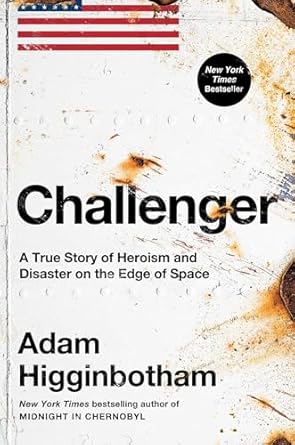
This is an impressively researched, detailed look at the 1986 destruction of the Space Shuttle Challenger, which took the lives of its crew: Dick Scobee, Michael Smith, Judy Resnik, Ron McNair, Ellison Onizuka, Greg Jarvis, and New Hampshire's Christa McAuliffe. The author, Adam Higginbotham, examines the lives of the people involved, nut just the astronauts, but relevant NASA personnel, contractors, and (eventually) accident investigators. The (very mistaken) decision to launch Challenger after freezing weather degraded the effectiveness of the O-rings that were supposed to seal the solid rocket booster joints is meticulously described, and how the judgment of the Morton Thiokol engineers was overruled by NASA bureaucrats.
It is a horrifying story all by itself. It is bookended on one end by the story of the Apollo 1 launchpad fire in 1967, which killed Gus Grissom, Ed White, and Roger Chaffee. And on the other end, a very brief retelling of the 2003 loss of the shuttle Columbia on re-entry, which killed astronauts Laurel Clark, Ilan Ramon, Michael P. Anderson, Rick Husband, William McCool, Kalpana Chawla, and David Brown.
It is an obvious, trivial fact that manned space travel is risky. But Higginbotham persuasively shows that all these deaths were avoidable. These 17 astronauts were, essentially, victims of the pressures of politics and bureaucracy. A major driver of the shuttle program was the need to "do something" post-Apollo: keep the budgetary money flowing to NASA and contractor facilities and personnel across the country. It's also hard to avoid the obvious PR gimmickry of the "Teacher in Space" effort. (And, although there's no evidence that it killed anyone, NASA's efforts of ensuring a "diverse" crew were pretty blatant.)
I was wondering how (or if) Higgenbotham was going to deal with a particularly nasty rumor: that the White House pressured NASA to launch on January 28, 1986 in order for Reagan to mention it in his State of the Union address scheduled for that evening. He does, briefly, noting that the most prominent advocate of this theory, Senator Ernest Hollings, pushed it with no evidence, and drew an angry rebuttal from William Rogers, head of the investigatory commission. (Higginbotham does occasionally express his contempt for the Reagan Administration, notably for the "star wars" effort. Easy to ignore.)
![[The Blogger]](/ps/images/barred.jpg)



